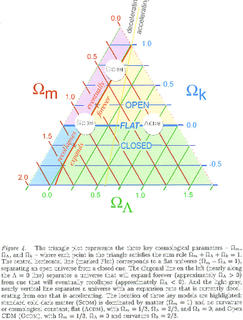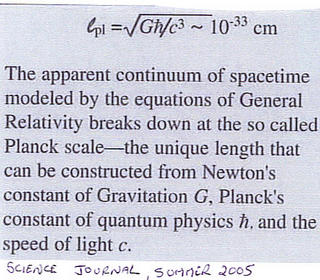This link was added to paper by Steinhardt as ole picture was used for perspective had been updated, so I gave updated link to Steinhardt, as well as his paper.
The Cosmic Triangle and the State of the Universe


The paper by Senthil et al. [9] is an attempt to address this issue mathematically. It deals specifically with a suspicion many of us have had that quark confinement, one of the most cherished features of the standard model, may be a collective effect that emerges at a phase transition and thus not fundamental at all. The paper is complicated, an unfortunate side effect of the difficulty of the task, for it is not generally possible to deduce emergent phenomena from first principles. The best one can do is postulate them and then demonstrate plausibility by showing that small corrections get smaller as the measurement scale increases. Such convoluted arguments are ripe with opportunities for mistakes, regardless of how careful the authors have been, so the test of emergent universality that counts is always experimental. This, in turn, forces the theory to address not quark confinement itself but an allegory of it one might hope to test in a table-top experiment. The logic is maddeningly indirect, but unfortunately the only approach that is legitimately scientific.
At the center of the wheel there is a raised central cairn, and several others on the periphery of the wheel. These have been alleged to have astronomical alignments. Astronomer John Eddy suggested that a line drawn between the central cairn and an outlying cairn at the Bighorn Medicine Wheel pointed to within 1/3 of a degree of the rising point of the sun at the summer solstice. The actual astronomical purpose of the design of these wheels remains controversial. The design may also have assisted in the performance of specific rituals and ceremonies that have been lost to us. The 28 spokes could indicate the lunar month, or the length of the female menstrual cycle.
The theory of relativity predicts that, as it orbits the Sun, Mercury does not exactly retrace the same path each time, but rather swings around over time. We say therefore that the perihelion -- the point on its orbit when Mercury is closest to the Sun -- advances.

Quantum geometry is a precise,mathematical theory in which the primary objects-the fundamentals excitations of geometry-are one dimensional. Just as a piece of cloth appears to be smooth, two dimensional continuum although it obviously is woven by one dimensional threads, the Spacetime of General Relativity appears as a four-dimensional continuum although it is in fact, a coherent superposition of these one-dimensional excitations.
If string theory is a theory of quantum gravity, then this minimum length scale should be at least the size of the Planck length,
T-duality is something unique to string physics. It's something point particles cannot do, because they don't have winding modes. If string theory is a correct theory of Nature, then this implies that on some deep level, the separation between large vs. small distance scales in physics is not a fixed separation but a fluid one, dependent upon the type of probe we use to measure distance, and how we count the states of the probe.
This sounds like it goes against all traditional physics, but this is indeed a reasonable outcome for a quantum theory of gravity, because gravity comes from the metric tensor field that tells us the distances between events in spacetime.



If conceived as a series of ever-wider experiential contexts, nested one within the other like a set of Chinese boxes, consciousness can be thought of as wrapping back around on itself in such a way that the outermost 'context' is indistinguishable from the innermost 'content' - a structure for which we coined the term 'liminocentric'.
The familiar extended dimensions, therefore, may very well also be in the shape of circles and hence subject to the R and 1/R physical identification of string theory. To put some rough numbers in, if the familiar dimensions are circular then their radii must be about as large as 15 billion light-years, which is about ten trillion trillion trillion trillion trillion (R= 1061) times the Planck length, and growing as the universe explands. If string theory is right, this is physically identical to the familiar dimensions being circular with incredibly tiny radii of about 1/R=1/1061=10-61 times the Planck length! There are our well-known familiar dimensions in an alternate description provided by string theory. [Greene's emphasis]. In fact, in the reciprocal language, these tiny circles are getting ever smaller as time goes by, since as R grows, 1/R shrinks. Now we seem to have really gone off the deep end. How can this possibly be true? How can a six-foot tall human being 'fit' inside such an unbelievably microscopic universe? How can a speck of a universe be physically identical to the great expanse we view in the heavens above? (Greene, The Elegant Universe, pages 248-249).
I am thinking about Lee Smolin’s history here in terms of discrete measures ( I am developing a perspective here in relation that will be complied later) How this effected the the way Lee may have viewed the background. I don’t want to speak for Lee Smolin, but I would like to make it simple.:)
Can this difference be as simple as, “a determination between “being discrete, and implying continuity“?
Where strings implying only tree features, while the approach to glast, as a “new view” supported by "Doubly Special Relativity", that Rovelli and Lee produced? This basis and history is what I am compiling.
The Greisen-Zatsepin-Kuzmin limit (GZK limit) is a theoretical upper limit on the energy of cosmic rays from distant sources.
This limit was computed in 1966 by Kenneth Greisen, Vadem Kuzmin and Georgi Zatsepin, based on interactions predicted between the cosmic ray and the photons of the cosmic microwave background radiation. They predicted that cosmic rays with energies over the threshold energy of 5×1019 eV would interact with CMB photons to produce pions. This would continue until their energy fell below the pion production threshold. Therefore, extragalactic cosmic rays with energies greater than this threshold energy should never be observed on Earth.
Unsolved problems in physics: Why is it that some cosmic rays appear to possess energies that are theoretically too high, given that there are no possible near Earth sources, and that rays from distant sources should have been absorbed by the cosmic microwave background radiation?A number of observations have been made by the AGASA experiment that appear to show cosmic rays from distant sources with energies above this limit (whimsically dubbed Oh-My-God particles). The observed existence of these particles is the so-called GZK paradox or cosmic ray paradox.
Seeking clarity in relation to experimental propositions of Glast 2006 and how it shall support one’s position over another? Will it?
High energy relevance had to meet each other in a way that cosmologically had something to do with high energy perceptions in relation to the trigger? Link on name.
The “beginning”, as first principles? Robert Laughlin saids no to “first principles”?:)
Steve Gubser (from Princeton) has just gave an interesting talk at the joint seminar in which he tried to convince us that structure formation (the process in which the early clumps of matter and the first galaxies were born) is a very interesting topic in cosmology, even for string theorists, in which some signs of new physics may be found if one tries to reproduce the observations.
Method A: ASSUME 1) that there is a real non-perturbative theory behind all the approximate calculations and 2) that it is relevant for nature. Then interpret various results, having to do with dualities, the landscape etc given these assumptions.
Method B: Look for evidence that the two assumptions of method A are true.
One evaluates results very differently, depending on whether one uses method A or method B. There is nothing wrong with using Method A from time to time, so long as the assumptions are made explicit, and the risks that are thereby taken on explicitly acknowledged. One can learn things that will turn out be true about the theory, if 1) is true, or about nature, if 2) is true. But one cannot do science only or even mostly by Method A, no matter how promising an idea may seem. What I find disturbing in your essay, and in many conversations with string theorists is that they reason by Method A but they do not state explicitly their assumptions. This puts me often in the uncomfortable situation, when discussing with a string theorist, of having to add, “but there is one more possibility, the theory might be wrong.”
Lee was, most recently, at Strings 2005, and he does hang out with his stringy colleagues at Perimeter.
I don’t know whether that counts for you, but it does for me.
The ground state of a three-dimensional box of dimension L can be obtained by setting n=1 for all three dimensions, giving an energy three times the ground state energy of the one-dimensional box. The ground state for the three-dimensional box would be